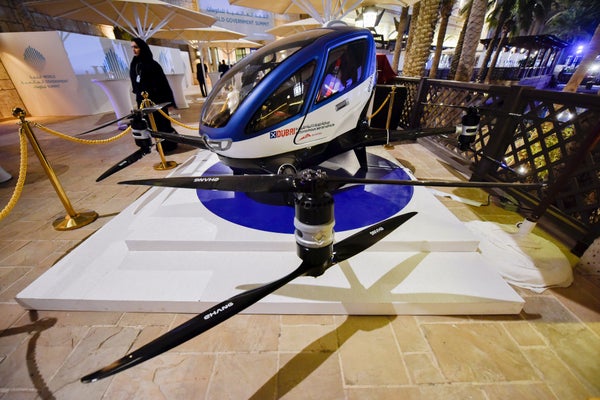The dream of the flying car could come down to earth before it gets off the ground. Rising in its place: a network of self-flying drones big enough to ferry individual commuters around town. That’s the future envisioned by several start-ups that are developing so-called “passenger drones,” which could shrink commute times from hours to minutes.
At first blush, human-carrying drones sound no more realistic than flying cars. Until recently inventors had never been able to marry automobiles and aircraft in a practical way. Yet a few companies have kept at it: Woburn, Mass.–based Terrafugia, for example, has since 2006 been developing Transition, a “roadable aircraft” that resembles a small airplane that can fold its wings and drive on roads. A personal flying car in every garage has proved to be a tough sell, however, and there are serious safety concerns about asking the average commuter to train for a pilot’s license and take to the skies.
Passenger drones, by contrast, would operate autonomously and leave the “roadable” part behind in favor of larger versions of aircraft that already exist. Chinese start-up EHANG last month announced it would debut its passenger drone service in Dubai in July. The EHANG184 autonomous aerial vehicle resembles an overgrown quadcopter with a passenger cab perched on top. Last October ride-hailing service Uber publicized its Elevate program for urban air transportation and announced support for companies building vehicles similar to the 184. Uber recently bolstered its plans by hiring Mark Moore, an aircraft engineer at NASA Langley Research Center and pioneer in vertical takeoff and landing (VTOL) aircraft designs. Several other companies, includingJoby Aviation and Silicon Valley start-ups Zee.Aero and Kitty Hawk—the latter two backed by Google co-founder Larry Page—are racing to develop electric-powered VTOL aircraft that could help make Elevate a reality. Terrafugia likewise plans to eventually offer a VTOL flying vehicle—the TF-X—in addition to the Transition.
On supporting science journalism
If you're enjoying this article, consider supporting our award-winning journalism by subscribing. By purchasing a subscription you are helping to ensure the future of impactful stories about the discoveries and ideas shaping our world today.
Passenger drone designs favor “distributed electric propulsion,” meaning instead of one large rotor powered by a large engine they have multiple propellers each powered by its own, smaller motor. This sacrifices lifting power and flight performance in exchange for mechanical simplicity and lighter weight—factors that could make them cheaper to operate. Quieter electric power would make the noise tolerable to city residents, although it remains to be seen how much weight such a vehicle could lift, and for how long.
With any of these vehicles, safety is the biggest concern and extends to both the aircraft and the automated systems flying them. Advanced artificial intelligence is needed to fly large numbers of autonomous aircraft without crashing them into one another or, say, the local news channel’s traffic helicopter. Carrying people from points A to B seems simple enough, but even the best AI struggles with surprises: What, for example, would a drone do if a landing area suddenly became unavailable? asks Sanjiv Singh, a Carnegie Mellon University robotics researcher and CEO of Near Earth Autonomy, a start-up developing intelligent flight systems. Instead of leaping to fully automated passenger drones, he suggests first testing the necessary AI in unmanned cargo runs. Early passenger services might include pilots assisted by AI co-pilots—a “mixed mode” approach that Singh helped develop for the U.S. military’s “Transformer” project (which more recently morphed into Lockheed Martin’s ARES project) to build a drone that could carry cargo or wounded soldiers.
Nevertheless, some experts are cautiously optimistic. The technological challenges can be overcome, says Marilyn Smith, associate director of the Vertical Lift Research Center of Excellence at Georgia Institute of Technology. “I think the big roadblock is the regulatory infrastructure that has to be put into place” to ensure safety, Smith says.
Regulators from the Federal Aviation Administration (FAA) have not issued guidance on passenger drones yet. The FAA is, however, working with NASA and private industry on ways to manage swarms of smaller delivery and emergency responder drones—rules that might also apply to larger self-flying aircraft. NASA’s approach relies on drone operators sending flight information to a centralized system—like an automated air-traffic control—that tracks the location of autonomous aircraft, says Parimal Kopardekar, principal investigator for NASA's Unmanned Aircraft Systems Traffic Management project. The system under development would provide a “common picture of what is going on in the airspace” so that drones can steer clear of other aircraft, Kopardekar says. A related NASA project—the Unmanned Aircraft Systems Integration in the National Airspace System is developing a “detect and avoid” system for drones to avert midair collisions.
Technical challenges aside, EHANG, Uber and others promoting the technology will have to find a way to convince the public to give their drones a whirl, something that requires a much bigger leap of faith than getting into the backseat of a self-driving car. Passenger drone makers are “obviously still in the incubationstages of technology development and improving the basics,” says Mike Hirschberg, executive director of the American Helicopter Society International, an organization for engineers and scientists that promotes VTOL technology. “But 20 or 30 years from now life may be a little like The Jetsons where you take advantage of the third dimension and have much more mobility, especially in urban close quarters where ground transportation is gridlocked.”
Passenger drone progress, however, may follow a sloping takeoff rather than vertical leap, depending on whom you ask. “This is not your father’s flying car,” Hirschberg says. “This is really serious work— and it’s going to happen.” Still, Carnegie Mellon’s Singh sees a long road ahead filled with lots of testing, analysis, regulation and efforts to win the public’s trust before the technology becomes a viable transportation option. “There is the danger of someone moving too fast and then having a problem that sets the industry back for some time,” he says.
